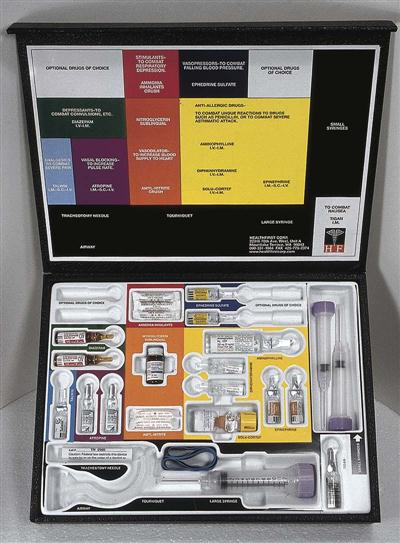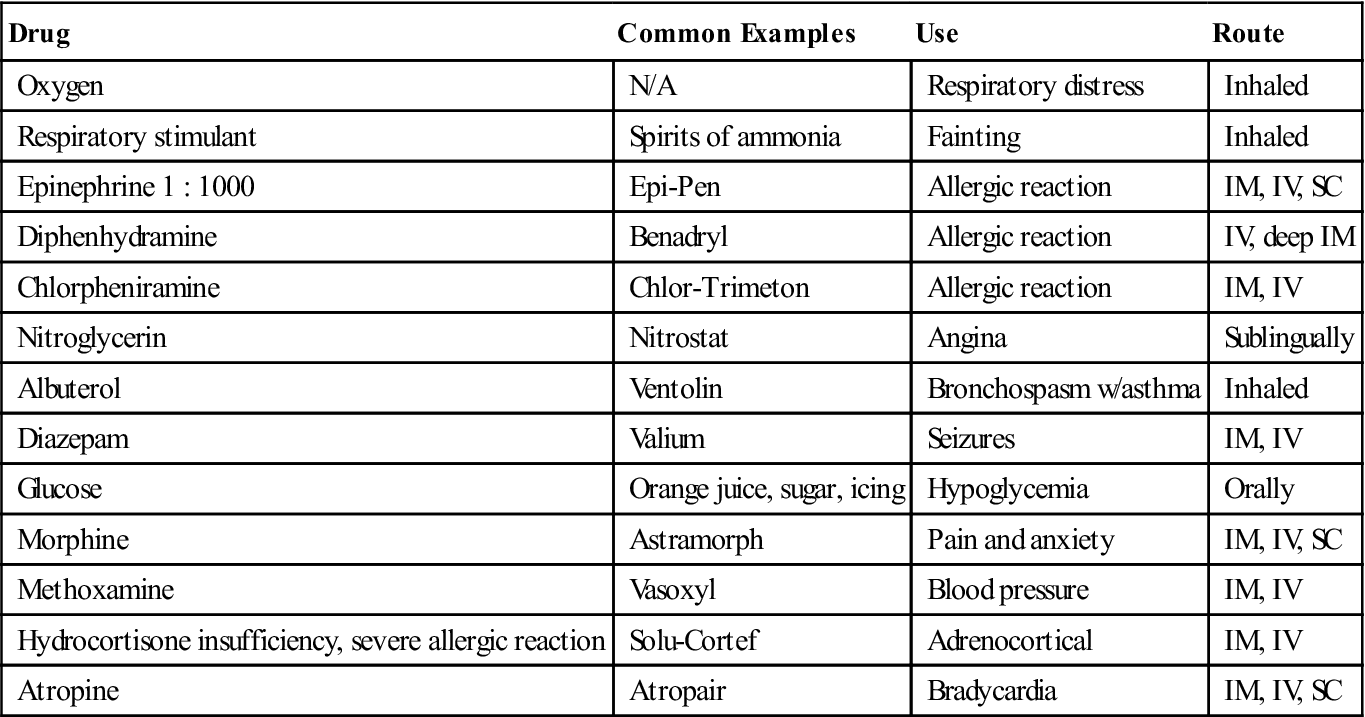Medical Emergencies in the Dental Office
Learning Objectives
1 Pronounce, define, and spell the Key Terms.
2 Describe the responsibilities of the dental office staff during a medical emergency.
3 List the emergency telephone numbers considered essential during a medical emergency.
5 Describe the primary signs and symptoms of a medical emergency.
Key Terms
Acute Myocardial Infarction
Allergen
Anaphylaxis
Angina Pectoris
Antigen
Asthma
Cerebrovascular Accident (CVA)
Diabetes Mellitus
Emergency
Epilepsy
Hyperglycemia
Hyperventilation
Hypoglycemia
Postural Hypotension
Signs
Symptoms
Syncope
An emergency is a condition or circumstance that requires immediate action to be taken for a person who has been injured or has suddenly become ill. When a medical emergency occurs, there is no time to refer to a medical textbook for answers. You must be prepared to respond immediately.
The population seen in the typical dental practice is diverse in age, with a wide range of medical conditions. This is why it is important for all personnel within the dental office to gain knowledge, confidence, and competency in:
• Understanding legal responsibilities when assisting in an emergency
• Being prepared for a medical emergency
• Continuing to assess the patient’s condition throughout a medical emergency
• Having specific equipment ready for use in an emergency and knowing how to use it
Preventing Emergencies
The easiest way for the dental office staff to help in preventing a potential medical emergency is requesting that each patient confirm an updated medical history. By having the patient provide changes in their health status and prescription medication, the dental team can feel confident in a patient’s health status. Once an update is completed, the patient will provide his or her signature to legally verify this information.
Knowledge of any chronic disorders, allergies, heart problems, and current medications allows the dentist to plan an individual dental treatment based on a patient’s specific needs.
Legal Responsibilities
Handling a medical emergency must be taken seriously, but the legal implications should not intimidate you or prevent you from doing your job.
In a professional situation, the law requires a healthcare worker to act or behave in a definable way known as the standard of care. This standard of care is determined by comparing people of similar training and experience as to how they would respond under similar circumstances, with similar equipment, and in the same setting.
The standard of care for handling medical emergencies requires that the dental assistant become certified in:
Emergency Preparedness
Every member of the dental team must be prepared for an emergency. A standardized procedure for the management of emergencies must be established and observed.
Assigned Roles
In the management of an emergency, the combined efforts of several trained staff members are most efficient when each person takes on a specific role. It is the responsibility of the dentist to define these roles. Most commonly, different staff will take on roles related to where they are commonly situated in the office (Box 13-1). Even though primary roles are assigned, staff members must be versatile and trained and prepared to fill other roles if necessary.
Routine Drills
Training must be kept current at all times. A mock emergency should be created in the dental office monthly so staff members can practice their roles, take part in cross-training, and be able to refine the emergency plan.
Emergency Telephone Numbers
A list of emergency telephone numbers should be posted next to each telephone throughout the office. Maintaining a current list of these phone numbers is an important part of emergency preparedness. The list should include phone numbers for local police, fire, and emergency medical service (EMS).
In most areas of the United States, all three agencies can be reached by dialing 911. However, the way emergency services function will vary widely depending on the geographic area and the population served. An important part of emergency preparedness is to know:
It is also important to list telephone numbers of the nearest hospital, physicians, and oral surgeons. These professionals might be able to offer the life support necessary when you are waiting for the EMS or another type of emergency response.
Emergency Supplies
In most dental offices, a portable standardized emergency kit is used to store and organize emergency supplies (Figure 13-1). The clinical staff is assigned the responsibility for maintaining and updating these supplies on a routine schedule.

An emergency drug kit must be readily accessible for the dentist. The types of drugs that should be considered for an emergency kit are provided in Table 13-1 along with their use and route of administration.
TABLE 13-1
Drugs Used in Medical Emergencies
< ?comst?>
| Drug | Common Examples | Use | Route |
| Oxygen | N/A | Respiratory distress | Inhaled |
| Respiratory stimulant | Spirits of ammonia | Fainting | Inhaled |
| Epinephrine 1 : 1000 | Epi-Pen | Allergic reaction | IM, IV, SC |
| Diphenhydramine | Benadryl | Allergic reaction | IV, deep IM |
| Chlorpheniramine | Chlor-Trimeton | Allergic reaction | IM, IV |
| Nitroglycerin | Nitrostat | Angina | Sublingually |
| Albuterol | Ventolin | Bronchospasm w/asthma | Inhaled |
| Diazepam | Valium | Seizures | IM, IV |
| Glucose | Orange juice, sugar, icing | Hypoglycemia | Orally |
| Morphine | Astramorph | Pain and anxiety | IM, IV, SC |
| Methoxamine | Vasoxyl | Blood pressure | IM, IV |
| Hydrocortisone insufficiency, severe allergic reaction | Solu-Cortef | Adrenocortical | IM, IV |
| Atropine | Atropair | Bradycardia | IM, IV, SC |
< ?comen?>< ?comst1?>

< ?comst1?>
< ?comen1?>
IM, Intramuscularly; IV, intravenously; NA, not applicable; SC, subcutaneously.
Oxygen is the most frequently used “drug” in a medical emergency. The ideal agent for resuscitation of a patient who is unconscious but still breathing is 100% oxygen.
Oxygen tanks (always color-coded green) must be checked weekly for any leaks. A portable unit of oxygen may be stored where it can be moved quickly into a treatment room if necessary. Note: If the dental office is equipped with a nitrous oxide/oxygen unit, oxygen from these units can be used for emergency situations.
To maintain readiness in an emergency situation, it is necessary to:
Patient Assessment
The dental staff must be aware that a medical emergency can occur at any time. For this reason, ongoing observation of the patient in the reception area, when moving to and from the dental treatment area, during a dental procedure, or when the patient is dismissed cannot be overemphasized.
Signs and Symptoms
When an emergency does occur, it is important to note in the patient’s record both symptoms and signs. A symptom is the patient’s report to you of what he or she is feeling or experiencing. The patient, for example, may say, “I feel dizzy,” or “I am having difficulty breathing,” or “My arm hurts.”
A sign is what you observe in a patient, such as a rapid pulse rate or a change in skin color. Because they are actually observed by you, signs are considered to be more reliable than symptoms.
Vital Signs
By being alert and using your eyes, ears, and hands, you can obtain a great deal of information about your patient. Monitoring vital signs (pulse, respiration, blood pressure, and temperature) is important. Observing the patient’s skin color gives an indication of blood circulation, and noticing the patient’s face and eyes helps in assessment of the patient’s level of consciousness.
Accurate assessment of vital signs, also known as diagnostic signs, is essential for proper patient management during an emergency. Vital signs should be reassessed every 10 to 15 minutes to determine whether the patient’s condition is remaining constant, improving, or deteriorating. (How to obtain vital signs is discussed in Chapter 11.)
Emergency Responses
Diagnosis of a specific condition is not your job. As a dental assistant, your responsibility is to recognize the symptoms and signs of a significant medical complaint, communicate this information to the dentist, and then assist with appropriate support and transportation procedures. Specific responses could include:
When you assess a medical emergency situation, a primary factor in determining the mode of treatment is consciousness of the patient. Commonly encountered medical emergencies described in this chapter are summarized in Procedures 13-3 through 13-9.
Syncope
Syncope, commonly known as fainting, is one of the most frequent medical emergencies in the dental office. Syncope is the imbalance in the blood distribution of the brain and larger vessels within the body. This reduced blood flow to the brain causes the patient to lose consciousness. Both psychological factors and physical factors can contribute to syncope (Box 13-2).
This situation is usually harmless to the patient as long as someone is there to protect them when they become unconscious. Syncope is one emergency that can be prevented by close observation of the patient.
A patient may complain of symptoms, and you may notice signs for several minutes before the patient actually loses consciousness.
Postural Hypotension
Postural hypotension, also known as orthostatic hypotension, is unconsciousness that can occur when the patient assumes an upright position too quickly. This is caused by lack of sufficient blood flow to the brain and may occur in a patient immediately following a sudden change in position, after receiving nitrous oxide and/or oxygen or IV sedation, or if the patient is pregnant.
The duration of unconsciousness is very brief—usually only seconds to minutes. If unconsciousness persists longer than this, there may be other causes, and appropriate action must be taken immediately.
Hyperventilation
Hyperventilation, is an increase in the frequency and/or depth of respiration that results in the patient taking in too much oxygen. The patient usually will remain conscious.
This medical emergency commonly occurs when a patient is extremely anxious or apprehensive before dental treatment. To prevent or reduce this problem, the dental team should be alert at all times and should be prepared to help the patient deal with severe apprehension in a positive manner.
Asthmatic Attack
Asthma is a pulmonary (breathing) disorder characterized by attacks of sudden onset during which the patient’s airway narrows, causing difficulty in breathing and accompanied by coughing and a wheezing sound. An allergic reaction, severe emotional stress, or respiratory infection can trigger an asthmatic attack.
Patients with asthma are aware of the sudden onset and should carry an inhaler that contains medication (a bronchodilator) used to relieve the first symptoms of an attack. It is very important that asthma be identified on the patient’s medical history, and that the patient brings the inhaler with him or her to each dental appointment.
See Procedure 13-4: Responding to the Patient With Breathing Difficulty.
Epilepsy
Epilepsy is a neurologic disorder characterized by recurrent episodes of seizures. In most patients, these are controlled with medication; however, under stressful conditions, they may still occur. Also known as convuls/>
Stay updated, free dental videos. Join our Telegram channel

VIDEdental - Online dental courses


